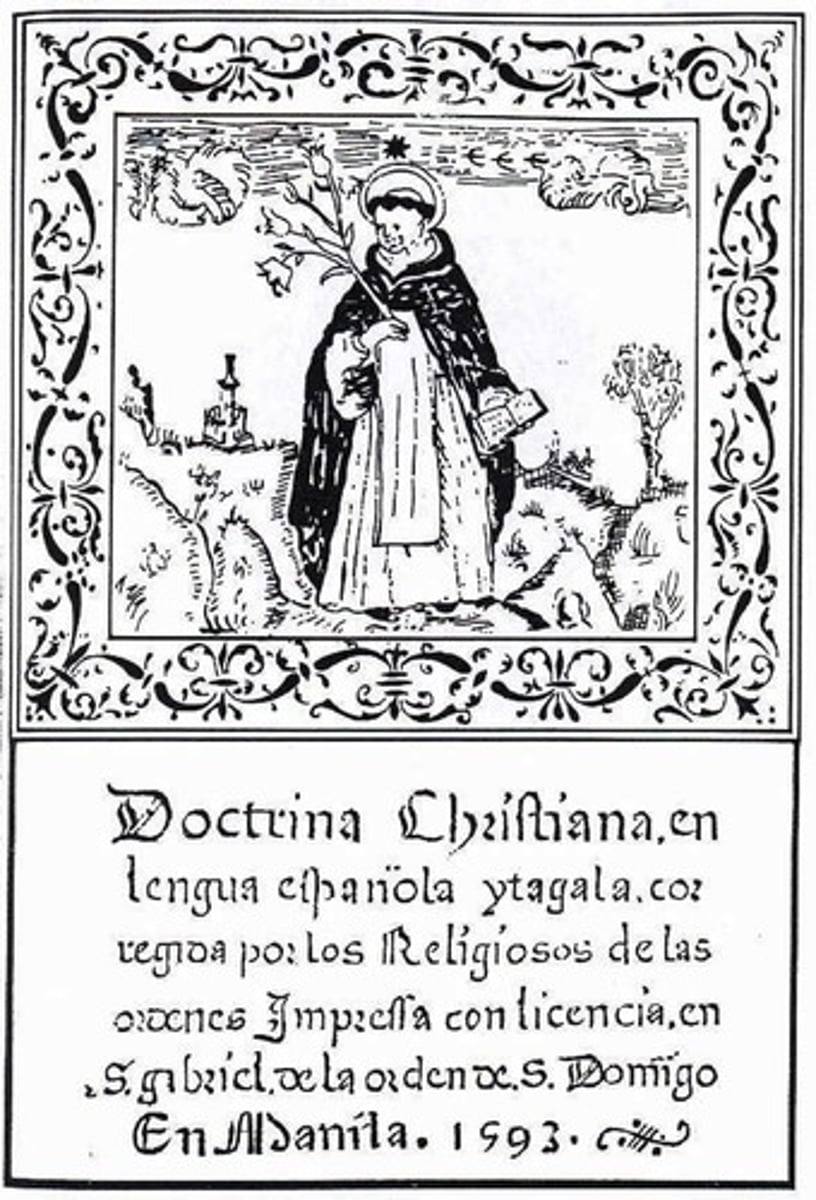Customs of the Tagalogs by Juan de Plasencia
1/54
There's no tags or description
Looks like no tags are added yet.
Name | Mastery | Learn | Test | Matching | Spaced |
|---|
No study sessions yet.
55 Terms
Fray Juan de Plasencia
One of the seven children of Pedro Portocarrero, he grew up in Extremadura during the Golden Age of Spain and was a Franciscan missionary in the Philippines.
Relacion de las Costumbres de Los Tagalos
A book written by Plasencia in 1589 that describes the political, social, economic, and cultural practices of Filipinos before they were Christianized.
Doctrina Christiana en Lengua Espanola Y Tagala
The first printed book in the Philippines published by Plasencia in 1593, used as reading material for Filipinos to deepen their faith.

Venerable
A title honored to Plasencia by the Franciscan Order after years of converting natives and teaching catechism.
gobernadorcillo
A position held by Filipinos during Spanish rule to ensure loyalty to the Crown, supervised by friars.
friars
Religious figures who performed administrative duties in local politics, including supervising elections and educating youth.
Miguel de Loarca
An encomendero of Panay who arrived in 1576 and wrote Relación de las Islas Filipinas in 1582, describing the way of life of Filipinos in Western Visayas.
Antonio de Morga
He came to the Philippines in 1595 and authored Sucesos de las Islas Filipinas, providing information about the Philippines in the late 16th century.
Archivo General de Indias
The location in Seville, Spain where the original text of Plasencia's Customs of the Tagalogs is kept.
Barangay
A tribal gathering ruled by chiefs, associated with the Malay people who arrived in the Philippines by boat.
Datu
The chiefs of the village who governed the people and were revered; they could punish subjects for offenses against them.
Maharlica
Individuals born free within the social hierarchy of a barangay, retaining their status unless they marry a slave.
Aliping Namamahay
A caste of individuals who serve their masters but can own property.
Aliping sa Guiguilir
Individuals considered slaves who serve their masters and can be sold off.
Property
Land area divided among the barangay, with restrictions on cultivation by outsiders unless inherited or bought.
Irrigated portions
Specific land areas within a barangay that were divided among its members.
tingues
Mountain ridges owned collectively by the barangay, not divided among individuals.
superstition
Beliefs or practices that are not based on scientific understanding, often related to religion or cultural traditions.
burying the dead
Cultural practices associated with the rituals and customs of interring deceased individuals.
12 Priests of the Devil
A term used in the context of worship and religious beliefs among the Tagalogs.
social hierarchy
The structure of status and caste within a barangay, consisting of Maharlica, Aliping Namamahay, and Aliping sa Guiguilir.
civic duties
Responsibilities performed by friars that included educating youth and assisting in local governance.
historical context
The background and circumstances surrounding the events and practices during the first century of Spanish rule in the Philippines.
primary source
A document or account that provides firsthand evidence or direct testimony about a historical event.
Spanish missionaries
Religious figures who contributed to the historiographical tradition in the Philippines during the Spanish period.
Blair and Robertson collections
A collection in which an English version of Plasencia's work appeared in volume VII.
Filipiniana Book Guild series
A series that published an English translation of Plasencia's work as part of its volume for pre-Hispanic Philippines.
Tingues
Mountain ridges owned collectively by barangays.
Property Rights
Laws governing land ownership and usage.
Chief's Fisheries
Designated fishing areas controlled by chiefs.
Marriage Customs
Traditions surrounding marriage and divorce practices.
Dowry
Property or money brought by a bride.
Adoption Value
Children receive double the purchase price upon adoption.
Simbahan
Place of worship in the chief's house.
Pandot
Festivals celebrated by the tribe.
Nagaanitos
Worship of ancestral spirits.
Bathala
Supreme deity worshipped by the Tagalogs.
Tala
Morning star, named by the Tagalogs.
Balatic
Greater Bear constellation recognized by Tagalogs.
Lic-ha
Idols representing various deities.
Dian Masalanta
Idol of love and generation.
Mangagauay
Deceptive healer pretending to cure sickness.
Mancocolam
Entity that can emit fire uncontrollably.
Osuang
Mythical being reported to fly and kill.
Superstition
Beliefs based on omens and signs.
Tigmamanuguin Bird
Bird whose song indicates good or bad omens.
Burial Practices
Customs for mourning and interring the dead.
Plasencia's Account
Primary source detailing Tagalog customs and beliefs.
Political Stratification
Social hierarchy within Tagalog society.
Datus
Chiefs or leaders in Tagalog communities.
Maharlikas
Noble class in Tagalog society.
Alipins
Servant class in Tagalog society.
Indigenous Calendar
Traditional system for tracking time and seasons.
Cultural Complexity
Depth of indigenous beliefs and practices.
Garments and Ornaments
Traditional clothing and jewelry worn by Filipinos.